Every business leader today faces the same pressing question: How do we start our company’s decarbonisation journey? As climate change accelerates, the need to reduce greenhouse gas emissions has never been more urgent. But where to begin? The path forward may seem daunting for organisations, but it’s also a chance to redefine your company’s future.
This guide will walk you through the critical steps, from gaining leadership buy-in to setting ambitious, science-backed targets. Along the way, you’ll discover how to align your efforts with industry best practices and make a meaningful impact on both your business and the planet.
Overview of the decarbonisation journey
The decarbonisation journey is a multi-step process that organisations undertake to reduce their greenhouse gas (GHG) emissions and transition to a more sustainable and responsible operating model. The critical stages involved in this journey are the following, as defined by Plan A.
1. Commitment from internal leadership
The journey typically begins with a commitment from your organisation's leadership to address climate change and reduce its carbon footprint. A critical step involves understanding and defining your company's climate ambitions. This step establishes a clear direction and goals for the decarbonisation efforts:
Leadership must ensure the organisation’s strategic initiatives align with its climate ambitions. This includes integrating sustainability into business models, operational processes, and corporate governance. Effective decarbonisation requires allocating sufficient resources, including financial investment, human capital, and technological innovation. Leadership must prioritise funding for sustainability projects, research, and partnerships.
2. Assessment
- The next step is to assess the organisation's current carbon emissions. This involves undertaking a comprehensive carbon footprint analysis to identify emission hotspots and the main emission drivers across the value chain.
- Each company should assess its emissions across three categories: Scope 1 for direct emissions, Scope 2 for indirect emissions from purchased energy, and Scope 3 for other indirect emissions, including those from the supply chain and customer usage. Companies must also be transparent about any categories not included in their carbon footprint, clearly defining their organisational and operational boundaries.
- The assessment should establish the most recent base year for a completed and verifiable corporate carbon footprint (CCF). In addition, this year should be representative of the company's standard conditions and, therefore, reflect emissions under normal operating activities (e.g., avoid choosing a year amid the COVID pandemic).
3. Decarbonisation planning (target setting and reduction pathways planning)
Target setting
- Once the base year has been established, organisations set emissions reduction targets, typically expressed as a percentage reduction compared to the base year.
- The targets should be ambitious, science-based, and aligned with the organisation's commitment to mitigate climate change. Companies can also benchmark themselves against relevant peers in their respective industries to gauge sector standards, if applicable.
- The definition of emissions reduction targets should be aligned with the overall company business strategy and, therefore, should count on the support from the company decision-makers.
- Other aspects relevant to setting a target include target type (absolute or intensity), target boundary (company-wide, selected facilities, selected geographies, etc.), and commitment period (short-term or long-term targets).
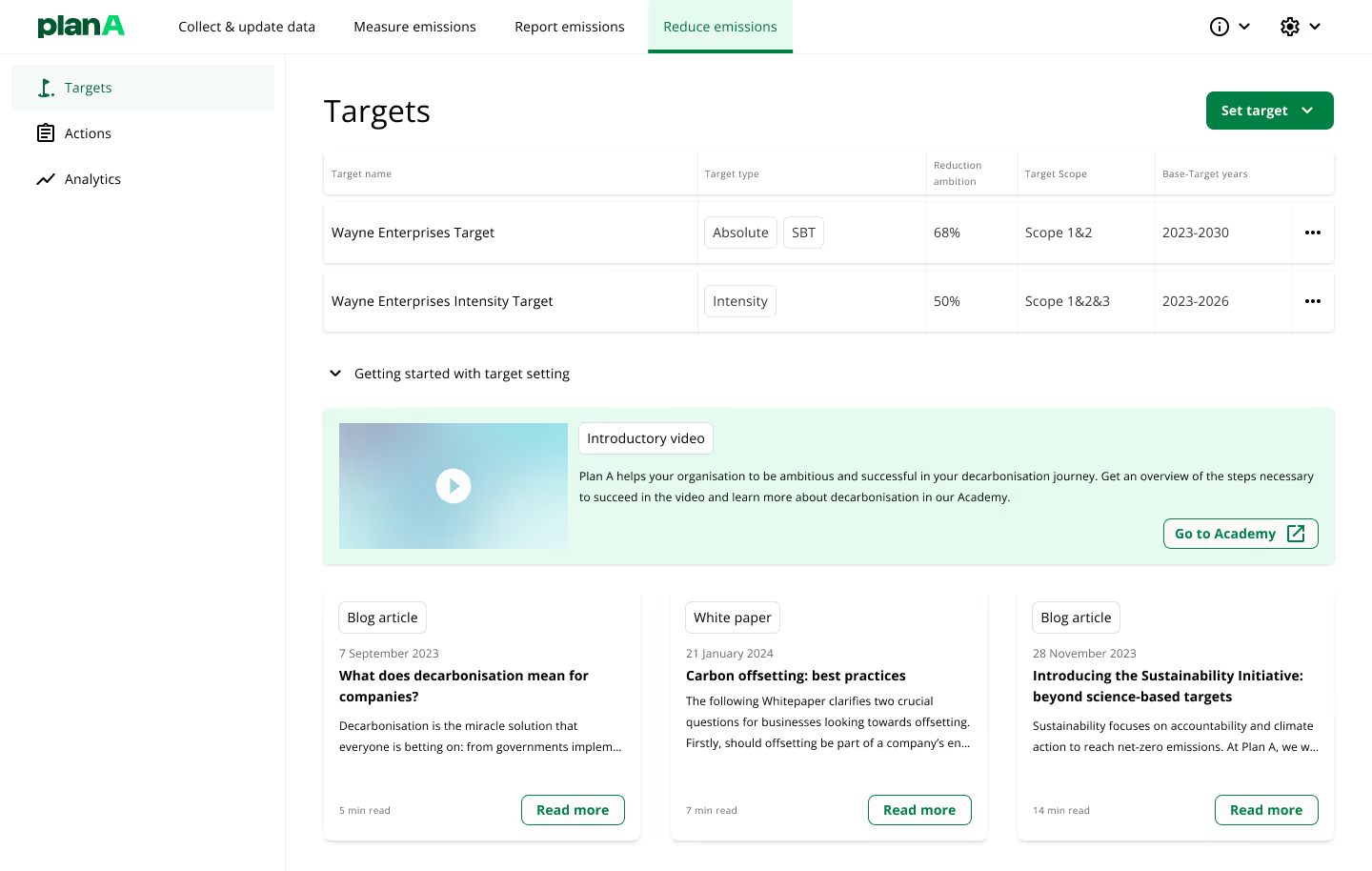
Credit: Plan A
Reduction efforts
- This stage involves the development of various tactics and actions within an overall emissions reduction strategy. As mentioned above, this strategy must be aligned with the company's business strategy, have C-level support, involve all employees and other relevant stakeholders, and have the physical resources (human, monetary, time, technological).
- After understanding its emission hotspots and what underlying factors contribute to emissions generation, the company should identify possible decarbonisation actions by analysing which will make the most impact. This can be done as a screening, considering the actions where the organisation has more control or influence to reduce its emissions, or with the help of more advanced tools such as the "marginal abatement cost curve" (MACC) or a return on investment analysis.
- The company should always verify that the intended reduction actions will be ambitious enough to achieve the established targets. First, the company should consider the main emission hotspots and the less evident emission sources when necessary to produce relevant and ambitious reductions aligned with the company's goals.
- Companies may invest in energy efficiency improvements, switch to renewable energy sources, optimise transportation and logistics, adopt sustainable procurement practices, or promote employee engagement in sustainability efforts as examples of basic actions that every company may implement. Then, specific actions should be taken depending on the organisation's context and emissions profile.
4. Public commitment (optional)
- This commitment often includes a public pledge or statement outlining the company's intention to become more sustainable and align with global climate goals, such as the Paris Agreement.
- It should be clear, specific, and measurable, outlining the company's steps and the targets it aims to meet.
- The commitment is typically built after establishing the organisation's base year emissions.
- Before finalising the commitment, engage with key stakeholders—employees, customers, suppliers, and investors—to gather input and build support, ensuring the commitment is comprehensive and scientifically sound.
- Include plans for regular updates to stakeholders on progress through sustainability reports, social media, or dedicated sections on the company website. This openness builds trust and accountability.
5. Implementation of decarbonisation actions
- Begin the practical application of your decarbonisation strategy by activating the detailed action plan developed in earlier stages. This involves a step-by-step rollout of specific measures tailored to your emission reduction targets.
- Focus initially on implementing actions that significantly impact your carbon footprint, as identified through your emissions assessment. Prioritisation should consider feasibility, cost-effectiveness, and potential for quick wins.
- Encourage your employees to participate actively in and own decarbonisation initiatives. Provide training and resources to help them contribute effectively. Similarly, keep external stakeholders informed and involved through regular updates and collaborative projects.
- Monitor implemented actions' effectiveness continuously. This real-time data allows for swift adjustments and optimisation of strategies, ensuring that your actions align with your decarbonisation targets.
- Keep detailed records of progress and challenges encountered during the implementation phase. This documentation will be invaluable for internal review and demonstrating compliance and commitment to public disclosures.
6. Review and calibrate
- Decarbonisation is an ongoing process. Companies must regularly monitor and report on their progress toward emission reduction goals. The review and calibration process must be conducted at least once a year.
- Strategies and targets may need to be adjusted and refined as circumstances change, new technologies emerge, or regulations evolve.
- Continuous improvement and adaptation are crucial to achieving long-term sustainability.
- Throughout this journey, companies may also engage with stakeholders, such as investors, customers, employees, and regulators, to communicate their progress and gather input and support.
The corporate decarbonisation journey is not a one-size-fits-all process. The specific actions adopted by each organisation will depend on its industry, size, location, and available resources. The journey is often guided by evolving sustainability standards and regulatory requirements. Companies that successfully navigate this journey can reduce their environmental impact, enhance their brand reputation, and contribute to global efforts to mitigate climate change.
The importance of the base year assessment in decarbonisation
The base year assessment is a fundamental step in the corporate decarbonisation journey. It supplies the data necessary for setting realistic targets, concentrating reduction efforts, tracking progress, and demonstrating commitment to stakeholders. With a clear understanding of initial emissions levels, developing an effective and credible decarbonisation strategy becomes more manageable.
Generally, the year of your most recent and complete Corporate Carbon Footprint (CCF) is an excellent candidate to use as the base year. The more data a company can collect and the fewer gaps must be accounted for, the better. Also, remember that using national averages in CCFs is generally considered lower-quality data than providing your company data. So, if you are deciding between two different base years, Plan A recommends choosing the year with data that is more accurate to the actual emissions of your company.
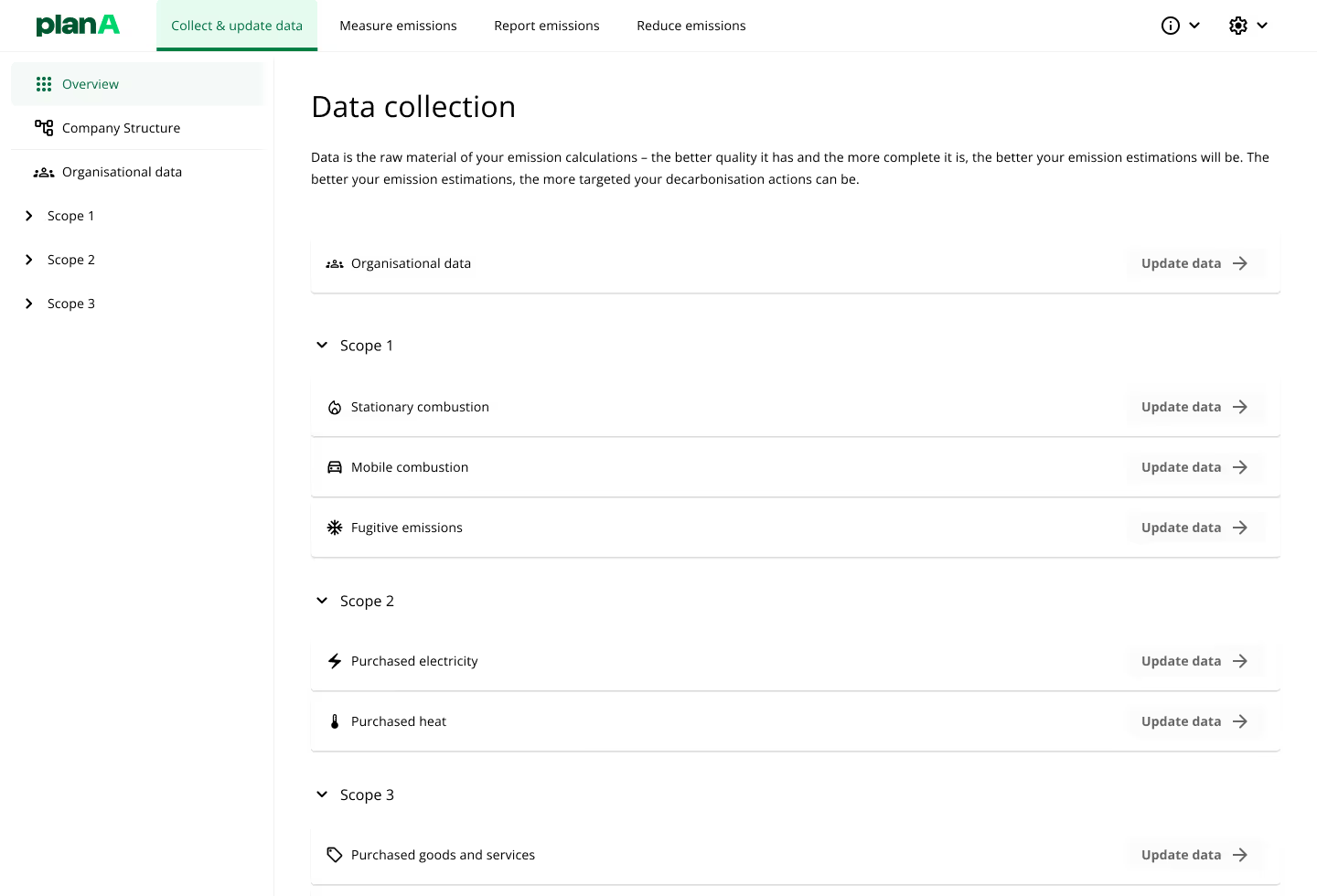
Credit: Plan A
The base year assessment holds significant importance in the context of corporate decarbonisation for several key reasons:
Where to focus for emissions reduction?
Embarking on the path to decarbonisation requires a clear understanding of where your company's emissions are most concentrated. By identifying these emission hotspots and involving stakeholders, you can strategically focus your reduction efforts for maximum impact.
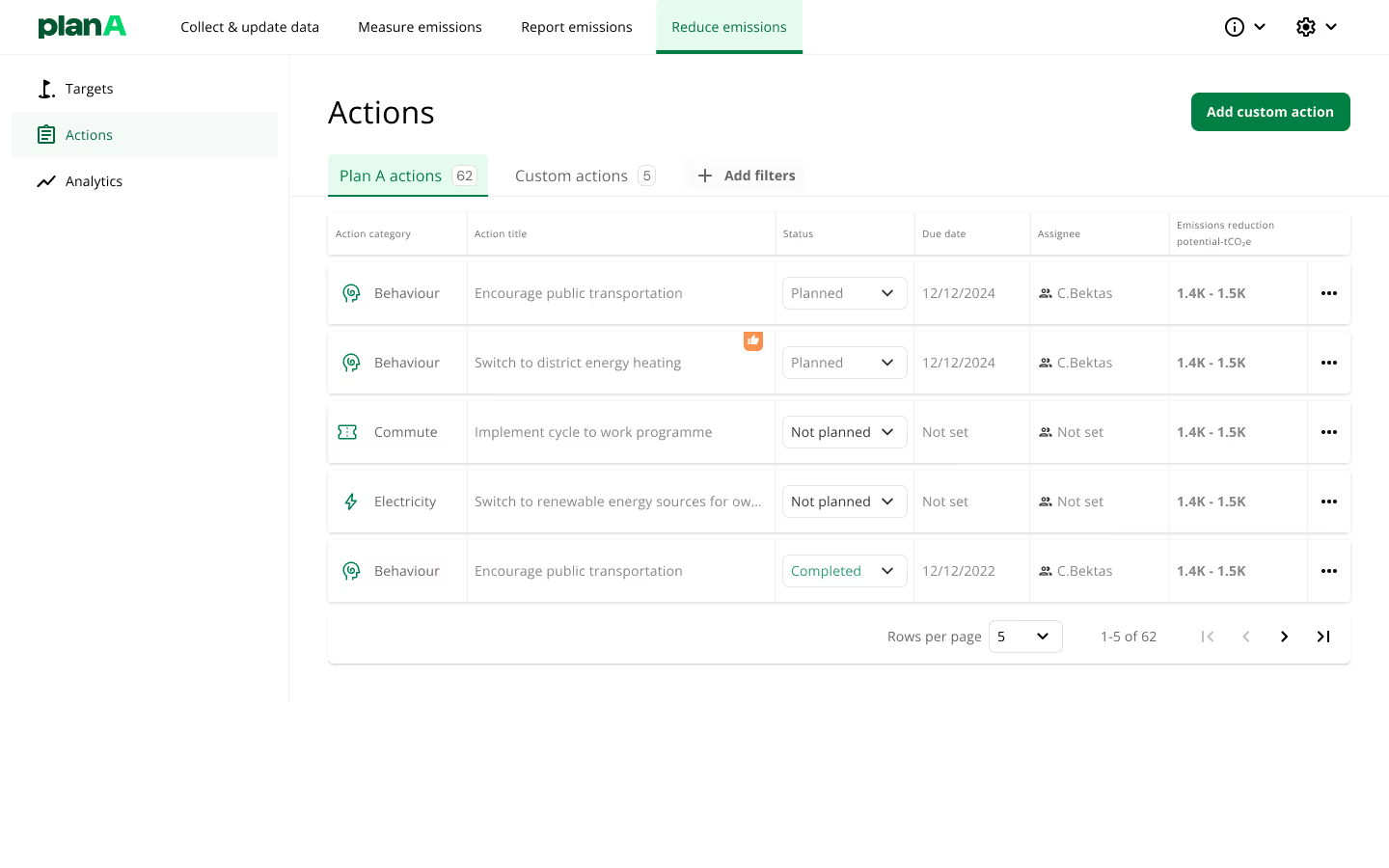
Credit: Plan A
Make sense of emission hotspots.
Understanding the different types and sources of emissions is vital for organisations to measure their carbon footprint effectively. Plan A uses the leading Greenhouse Gas (GHG) Protocol Corporate Standard to calculate a company's greenhouse gas emissions across the three scopes. In doing so, an accurate picture of a company’s total CO2 emissions within defined operational and organisational boundaries over a specified period can be realised.
Effective data collection is the cornerstone of gaining an accurate overview of emissions hotspots and developing robust decarbonisation strategies in an increasingly competitive and environmentally-conscious business landscape. Access to reliable and consistent data remains a significant hurdle for many companies. A Global Reporting Initiative (GRI) study found that 90% of organisations surveyed faced difficulties obtaining accurate and comprehensive emissions data. Furthermore, 80% of respondents identified the need for standardised methodologies and tools as a barrier to practical carbon accounting.
Data-driven insights help companies make informed decisions, optimise their operations, and align with sustainability goals. As such, companies must implement comprehensive data collection processes. Companies that use technology to streamline data management and analysis and leverage these insights will ultimately be able to drive meaningful progress towards sustainability and ESG performance.
However, the quest for the most accurate data may be too time and resource-consuming and, therefore, should not be the barrier to implementing decarbonisation actions since, for many industry sectors, the main emission drivers are already clearly identified (e.g., for companies within the food industry that use agricultural commodities, one primary source of emissions is deforestation and soil management practices). Accurate data should be the tool for refining targets, monitoring progress, and reporting. Still, it should be able to take action once the first screening of emissions hotspots has been finalised.
Reduce Scope 3 as much as possible.
The three scopes of GHG emissions—Scope 1 (direct emissions), Scope 2 (indirect emissions from purchased energy), and Scope 3 (other indirect emissions)—present varying degrees of complexity. Therefore, companies will ultimately be required to identify the largest source of emissions within their operations and supply chain, also known as emissions hotspots. Organisations must prioritise different emission scopes and categories and implement a reduction strategy and actions with the most significant potential impact on their total CCF.
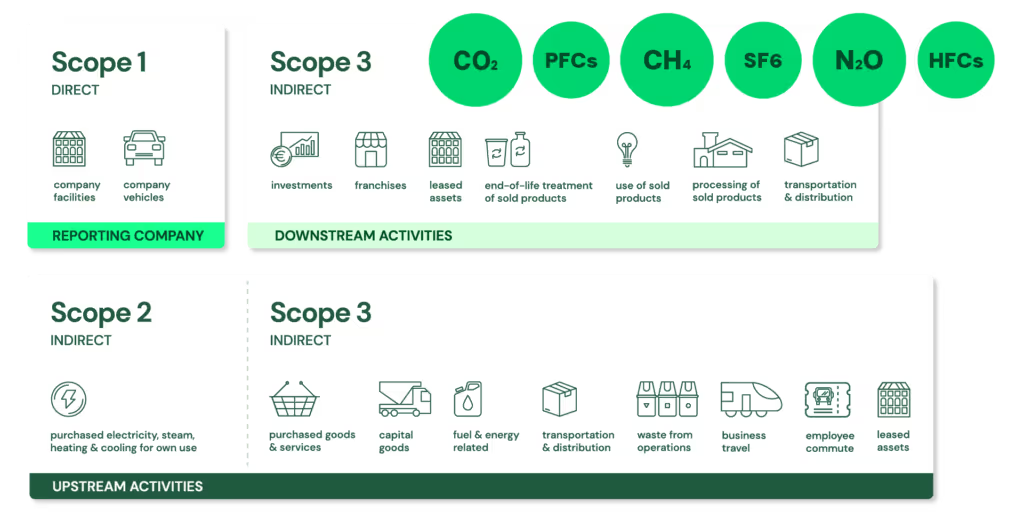
Credit: Plan A
Scope 3 emissions are the largest and most complex category to measure within a company's carbon footprint. This complexity often arises when collecting accurate data from suppliers, particularly those in the upper tiers—beyond the immediate or Tier 2 suppliers, further up in the supply chain. Additionally, getting data on the emissions generated from using a company's products by independent and geographically dispersed consumers adds another layer of difficulty. Despite these challenges, Scope 3 emissions are crucial to understand as they can comprise, on average, 90% of a company’s total carbon footprint.
Delving into the broader impact, studies by CDP indicate that the emissions from a company's supply chain can be significantly higher than those from direct operations, averaging 11.4 times greater. This statistic highlights supply chains' critical role in a company's emissions profile. Further emphasising the importance of addressing Scope 3 emissions, it is estimated that approximately 60% of global emissions originate from supply chains. This considerable percentage underscores the pivotal role of calculating and reducing Scope 3 emissions.
According to the GHG Protocol, a company’s impacts, risks, and opportunities related to GHG emissions and climate change depend on its upstream and downstream effects, not only direct operations. Consequently, companies seeking to reap the strategic benefits of decarbonisation must prioritise reducing emissions from global supply chains. Therefore, gaining visibility into these indirect emissions sources is crucial to developing a comprehensive decarbonisation strategy.
To accurately and efficiently prioritise efforts across different emissions scopes and categories, it is strongly recommended that businesses leverage the power of carbon accounting technologies that are certified by TÜV Rheinland and are compliant with the GHG Protocol. Businesses with the latest climate science at their fingertips via Plan A’s Platform can efficiently and effectively compare emissions across all scopes and facilities, obtain benchmarks for their industry, and identify emissions hotspots that they can immediately take action against. Meanwhile, Plan A’s decarbonisation software enables users to customise and tailor their emissions dashboard to suit the specific business needs and focus areas required for decarbonisation.
Engage your stakeholders
Businesses cannot undergo a green transition independently—many stakeholders must be actively engaged in this journey. As such, companies that commit to reducing their carbon emissions must understand the best stakeholder engagement and management practices to ensure an efficient and effective transition, especially for collectively reducing emissions along the value chains.
A wide range of stakeholder groups, including employees, consumers, B2B customers (suppliers), investors, shareholders, and non-government organisations (NGOs), either influence or are influenced by business activities. In the following paragraphs, we will focus on the more relevant stakeholders for decarbonisation in the value chain: suppliers, investors, and users. Hereafter, we will use the word stakeholders to limit the meaning to these three groups.
Undertaking stakeholder engagement activities is a vital formative step when tackling decarbonisation initiatives. Collaborating with stakeholders allows businesses to obtain access to Scope 3 emissions data and other relevant ESG information. It ensures companies develop solid relationships and communication channels to improve data accuracy and stakeholder trust.
Companies can follow these steps to engage stakeholders:
1. Establish a communication process
One of the main priorities of a stakeholder engagement strategy is developing a robust communication process. This will help engage stakeholders, communicate decarbonisation targets, and build the trust necessary to collectively share the valuable information needed to achieve reduction targets. Additionally, companies should truthfully communicate the role of sustainability within their operations and their progress towards targets with upstream (suppliers, investors) and downstream (users, consumers) stakeholders to build trust and brand value. This may involve investing in new physical assets and reallocating capital, redesigning products, or utilising their communications channels to highlight sustainable actions.
2. Analyse risks and opportunities
This is vital in managing stakeholders (particularly investors). Stakeholders want to see that businesses have thoroughly analysed both the risks and the opportunities that sustainability poses to them and their value chain. Companies should develop ongoing capabilities for their holistic and dynamic assessments of transition-related risks to be communicated, allowing for opportunities relating to shifts in regulations, investor preferences, consumer behaviours, and competition to be evaluated by the business and its stakeholders.
3. Implement effective and high-quality data collection mechanisms
Companies can start by selecting a well-defined sample of key emissions contributors (suppliers and consumers) to obtain the necessary data (e.g., through surveys, questionnaires, applications, etc.) and accurately measure their contribution to CCF and emissions reductions.
At this point, companies should define reporting guidelines to ensure the information collected is relevant, truthful, complete and accurate. These guidelines may include periodicity of collection, data collection systems (physical or digital), focus of the data to be collected (focused on emissions, reduction actions, or a combination of both), accountability of the parties providing and receiving the information including confidentiality parameters and other legal aspects that may influence the data collection. After a trial period, companies can extend the approach to a more significant number of stakeholders.
4. Reinforce collaboration
Collaboration requires common understanding and goals. With this, it is possible for different parties to feel incentivised to cooperate. This is also true for the topic of decarbonisation. With the aid of the communication process described in the first point, companies should communicate to their stakeholders the motivations, needs, objectives, and targets for their reduction strategy and why stakeholder cooperation is necessary. Companies should also identify what may motivate their stakeholders to cooperate or not; for instance, some suppliers may require tangible incentives (e.g., price premiums, longer/safer contracts), others may need financial support to take action, or consumers may want to feel more personally involved with companies through prices, recognition, etc.
Establishing common objectives is another powerful means for strengthening cooperation, especially with suppliers and investors. Companies and their suppliers and investors may be subject to the same climate and environmental regulations, or they may all be pursuing their decarbonisation strategies. Sharing the effort can reduce the risks and resource burden required to achieve significant emissions reductions. These are examples of hidden motivations from which companies can benefit.
5. Evaluate and optimise your processes
Evaluation and optimisation are integral parts of any process. Companies should assess which aspects of their stakeholder engagement strategies work and which require further refinement. Following this assessment and optimisation, companies can be better prepared to expand their engagement with stakeholders further along their value chains, which can significantly influence reduction.
What is the difference between emission reduction and emission compensation?
The urgency is apparent: more than incremental steps to address GHG emissions will be needed to address climate change. According to the Intergovernmental Panel on Climate Change (IPCC), the world has until 2030 to cut human-caused carbon dioxide (CO2) emissions in half to maintain a 50% chance of avoiding the worst effects of climate change. To sustain this chance, 2050 CO2 emissions must reach “net-zero” – where emissions are balanced with removals. Such reductions will require worldwide action from businesses but also national and local governments and civil society.
Emissions reduction via the implementation of decarbonisation actions broadly involves the reduction of all human-made carbon emissions into the atmosphere. Decarbonisation is achieved through cross-cutting measures to reduce or eliminate carbon emissions from an organisation's activities. Decarbonisation differs from climate neutrality because it seeks to reduce absolute carbon emissions and intensity. Climate neutrality does not necessarily include decarbonisation actions, as climate neutrality can be achieved through solely buying carbon credits.
In contrast, emissions compensation via offsetting entails reducing or removing carbon dioxide or other greenhouse gas emissions to compensate for emissions made elsewhere. Carbon offset projects allow companies and individuals to invest in quantifiable environmental projects to balance carbon emissions. Offsets are calculated relative to a base year, representing a hypothetical scenario for emissions without the mitigation project generating the offsets. Examples of offsetting technologies include reforestation, biodiversity conservation, and carbon capture.
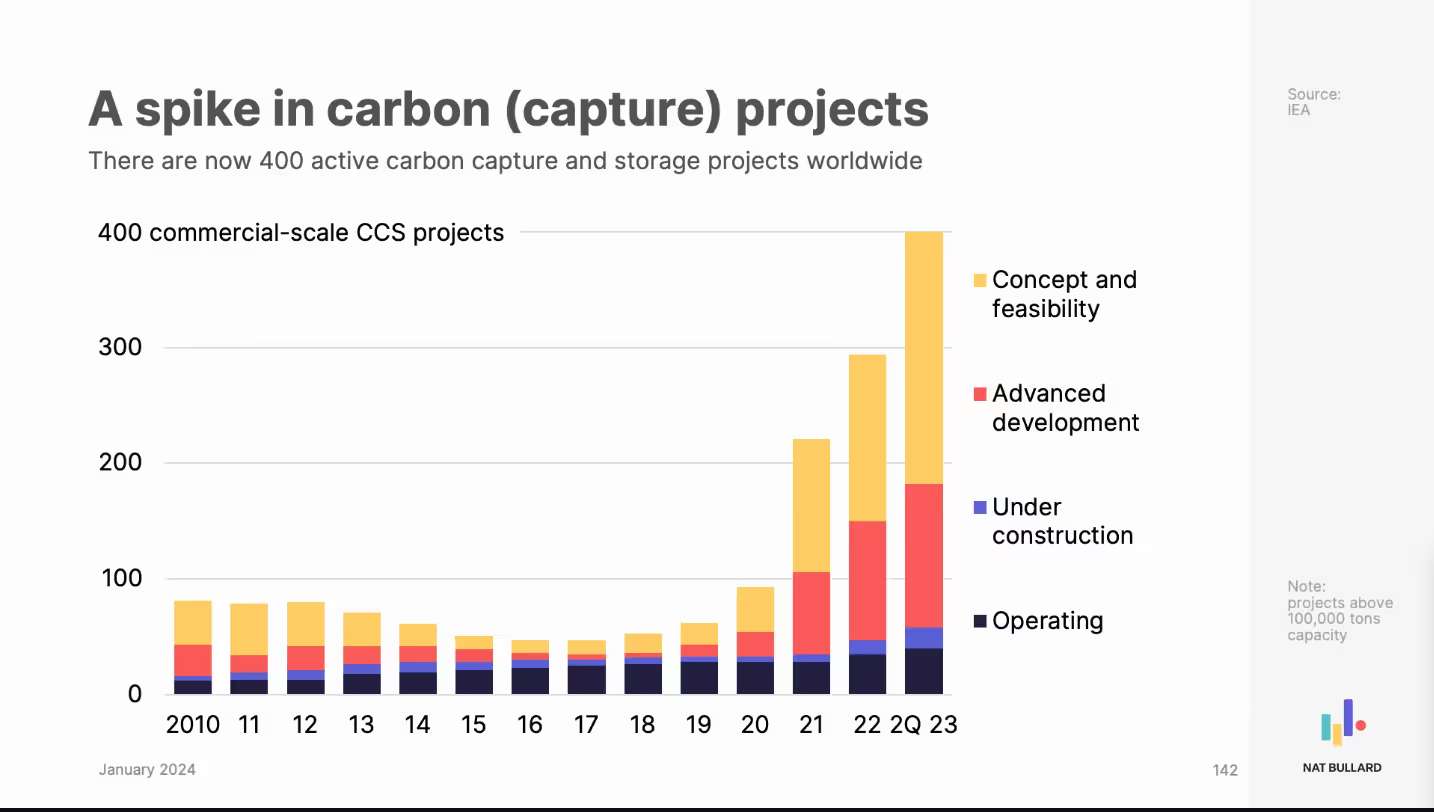
Credit: Nat Bullard
Most importantly, offsets should not be counted as part of the CCF nor as reductions toward meeting a science-based target (SBT). Instead, companies should account for reductions resulting from direct action within their operations or value chains. Many companies mistakenly believe they must offset all their carbon emissions to reach net zero. However, offsetting does not inherently lead to decarbonisation. There is increasing regulatory pressure to focus on decarbonisation within the value chain before engaging in offsetting activities. Companies should prioritise reducing their emissions and work with suppliers to minimise emissions throughout the value chain; offsets could only be considered an option for companies wishing to finance additional reductions beyond the SBT.
By securing leadership commitment, assessing your carbon footprint, setting ambitious targets, and implementing impactful reduction strategies, your organisation can lead the global effort towards decarbonisation. Remember, the journey doesn't end with the first steps; it’s an ongoing process of refinement, stakeholder engagement, and continuous improvement. The time to start is now—because the future of your business depends on it.




.jpg)

.webp)



